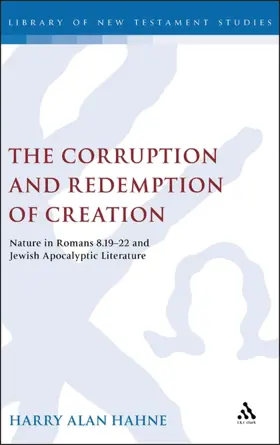

The Corruption and Redemption of Creation: Nature in Romans 8.19-22 and Jewish Apocalyptic Literature
in Library of New Testament Studies
Pages
286
Publisher
T&T Clark
Published
1/23/2007
ISBN-13
9780567030559
Nature plays an important and often neglected role in Jewish apocalypses. Most Second Temple Jewish apocalypses (ca. 200 BC - AD 100) do not oppose the material world, but view nature as damaged by human and angelic sin. Rather than expecting God to destroy the world, many look forward to God's dramatic eschatological deliverance of nature from corruption. Although Romans 8:19-22 was not written in the genre of an apocalypse, it shares the basic apocalyptic world view. The Apostle Paul follows that stream of apocalyptic thought that looks forward to the transformation of creation by an eschatological divine act, the reversal of the damage caused by sin, and the perfection of nature to share glory with redeemed humanity. A comparison of nature in Jewish apocalypses and Romans 8:19-22 reveals important insights into the theology of early Judaism and its influence on early Christian thought.
- Table of Contents
- Introduction
- Part I: History of Research on Romans 8:19-22
- Chapter 1: History of the Interpretation of Romans 8:19-22 A survey of approaches to Romans 8:19-22 from the Patristic era to modern times.
- Chapter 2: History of Research on the Apocalyptic Background to Romans 8:19-22 Characteristics of Jewish Apocalyptic Literature The Corruption and Redemption of Creation in Jewish Apocalyptic Writings The Relationship of Paul's Thought to Jewish Apocalyptic Writings The Apocalyptic Dimensions of Romans 8:19-22
- Part II: The Corruption and Redemption of Creation in Jewish Apocalyptic Literature In each primary source
- Chapter 3: Early Jewish Apocalyptic Literature (Third to Second Century B.C.) 1 Enoch Book 1 (Ch. 1-36): The Book Of Watchers 1 Enoch Book 3 (Ch. 72-82): The Astronomical Book 1 Enoch Book 4 (Ch. 83-90): The Book Of Dreams 1 Enoch Book 5 (Ch. 91-108): The Epistle Of Enoch The Book Of Jubilees
- Chapter 4: 2 Enoch (Slavonic Enoch)
- Chapter 5: Jewish Apocalyptic Literature From the First Century A.D. 1 Enoch Book 2 (Ch. 37-71): The Book Of Parables 4 Ezra 2 Baruch The Apocalypse of Moses and the Life of Adam And Eve
- Chapter 6: Summary: The Corruption And Redemption Of Creation In Jewish Apocalyptic Literature General Trends The Corruption of Creation Causes of the Corruption of Creation Aspects of the Corruption of Creation The Degree of Corruption The Redemption of Creation The Relationship Between the Old and New Creation The Future Dwelling Place of the Righteous The Eschatological Changes in Creation Nature in the Future World The Personification of Creation Types of Personification Functions of Personification
- Part III: Interpretation of Romans 8:19-22 in the Light of Jewish Apocalyptic Literature
- Chapter 7: Exegesis Of Romans 8:19-22 The theme and context of the passage Structure of the passage The meaning of kts The interpretation of various verses The themes of the corruption of creation, the redemption of creation and the personification of creation
- Chapter 8: Comparison of Romans 8:19-22 and Jewish Apocalyptic Literature on the Corruption and Redemption Of Creation The Corruption of Creation The Impact of Sin on the Natural World The Cause of Cosmic Corruption Is Creation Itself Fallen or a Victim Of Sin? Aspects of the Corruption of Creation The Period During Which Creation Is Corrupted The Solidarity Between Humanity And The Natural World The Redemption of Creation The Hope of the Eschatological Redemption of Creation The Relationship Between the Old and the New Creations The Time of the Redemption of Creation The Redemption of Creation and the Eschatological Destiny of the People of God Eschatological Changes in the Natural World Two Age Dualism The Solidarity Between Humanity and the Natural World The Personification of Creation Aspects of the Natural World Personified Types of Personification The Functions of Personification The Function of the Corruption and Redemption of Creation Themes
- Conclusions